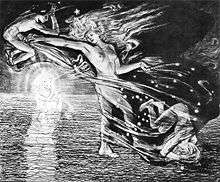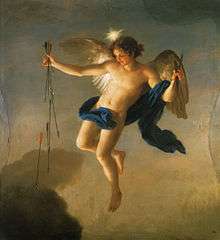Phosphorus (morning star)
Phosphorus (Greek Φωσφόρος Phōsphoros) is the Morning Star, the planet Venus in its morning appearance. Φαοσφόρος (Phaosphoros) and Φαεσφόρος (Phaesphoros) are forms of the same name in some Greek dialects.
._Engraving_by_G.H._Frezza%2C_1704%2C_Wellcome_V0035916.jpg)
This celestial object was named when stars and planets were not always distinguished with modern precision.
Another Greek name for the Morning Star is Heosphorus (Greek Ἑωσφόρος Heōsphoros), meaning "Dawn-Bringer". The form Eosphorus is sometimes met in English, as if from Ἠωσφόρος (Ēōsphoros), which is not actually found in Greek literature,[1] but would be the form that Ἑωσφόρος would have in some dialects. As an adjective, the Greek word φωσφόρος is applied in the sense of "light-bringing" to, for instance, the dawn, the god Dionysos, pine torches, the day; and in the sense of "torch-bearing" as an epithet of several god and goddesses, especially Hecate but also of Artemis/Diana and Hephaestus.[2]
The Latin word lucifer, corresponding to Greek φωσφόρος, was used as a name for the morning star and thus appeared in the Vulgate translation of the Hebrew word הֵילֵל (helel), meaning Venus as the brilliant, bright or shining one, in Isaiah 14(Isaiah 14:12), where the Septuagint Greek version uses, not φωσφόρος, but ἑωσφόρος. As a translation of the same Hebrew word the King James Version gave "Lucifer", a name often misunderstood as a reference to Satan. Modern translations of the same passage render the Hebrew word instead as "morning star", "daystar", "shining one" or "shining star". In Revelation 22 (Revelation 22:16), Jesus is referred to as the morning star, but not as lucifer in Latin, nor as φωσφόρος in the original Greek text, which instead has ὁ ἀστὴρ ὁ λαμπρὸς ὁ πρωϊνός (ho astēr ho lampros ho prōinos), literally: the star, the shining one, the dawn.[3][4][5] In the Vulgate Latin text of 2 Peter 1 ( 2 Peter 1:19) the word "lucifer" is used of the morning star in the phrase "until the day dawns and the morning star rises in your hearts", the corresponding Greek word being φωσφόρος.
Objectively, Venus is the "light bringer" as she appears most brightly in the sky in December (optical illusion due to days being shorter); the most regular appearance of the planet signalled a beginning of "rebirth" phase where the days would get longer and winter would end.
Alternatively, mythologically, the morning and the evening stars are Venus and Sirius, and the frequent error in mistaking one for the other becomes incorporated in various stories across several cultures.
Known as Sopdet in Egypt, as Sotor, Σωτήρ "Savior" in Ancient Greek astrological texts, and as Seth in Babylonian/Jewish astrology, Sirius "the Eastern Star" and its corresponding partner Venus, known as Ishtar, Ester, Asherah, Astarte, become the Christ and the Anti-Christ.
Sirius "the dog star" is relevant in June and Venus in December, and so Venus in the constellation Virgo ("the Virgin") announces the appearance of Sirius the Savior (on the opposite side of the zodiac circle, ie "gives birth").
The correction of the Egyptian solar calendar by way of helical rising of the Anubis star, Seth, another name for Sirius, also permitted the alignment of the lunar and the solar calendars and predicted the flooding of the Nile thus becoming the Seth or Sotor (Savior) star.
This fit nicely into Egyptian political mythology where Upper and Lower Egypt and their unification were often associated with the being of the Pharaoh - in his title as "King of Upper and Lower Egypt, the morning and the evening star," both Venus and Sirius.
Venus
The morning star is an appearance of the planet Venus, an inferior planet, meaning that its orbit lies between that of the Earth and the Sun. Depending on the orbital locations of both Venus and Earth, it can be seen in the eastern morning sky for an hour or so before the Sun rises and dims it, or (as the evening star) in the western evening sky for an hour or so after the Sun sets, when Venus itself then sets. Venus is the brightest object in the sky after the Sun and the Moon, outshining the planets Jupiter and Saturn but, while these rise high in the sky, Venus never does. This may lie behind myths about deities associated with the morning star proudly striving for the highest place among the gods and being cast down.[6]
Mythology

In Greek mythology, Hesiod calls Phosphorus a son of Astraeus and Eos,[7] but other say of Cephalus and Eos, or of Atlas.[8]
The Latin poet Ovid, speaking of Phosphorus and Hesperus (the Evening Star, the evening appearance of the planet Venus) as identical, makes him the father of Daedalion.[9] Ovid also makes him the father of Ceyx,[10][11] while the Latin grammarian Servius makes him the father of the Hesperides or of Hesperis.[8]
While at an early stage the Morning Star (called Phosphorus and other names) and the Evening Star (referred to by names such as Hesperus) were thought of as two celestial objects, the Greeks accepted that the two were the same, but they seem to have continued to treat the two mythological entities as distinct. Halbertal and Margalit interpret this as indicating that they did not identify the star with the god or gods of mythology "embodied" in the star.[12]
"Hesperus is Phosphorus"

In the philosophy of language, "Hesperus is Phosphorus" is a famous sentence in relation to the semantics of proper names. Gottlob Frege used the terms "the evening star" (der Abendstern) and "the morning star" (der Morgenstern) to illustrate his distinction between sense and reference, and subsequent philosophers changed the example to "Hesperus is Phosphorus" so that it utilized proper names. Saul Kripke used the sentence to posit that the knowledge of something necessary — in this case the identity of Hesperus and Phosphorus — could be discoverable rather than known a priori.
Latin literature
The Latin word corresponding to Greek "Phosphorus" is "Lucifer". It is used in its astronomical sense both in prose[13] and poetry.[14] Poets sometimes personify the star, placing it in a mythological context.[15]
See also
References
- There is no entry for this form in Liddell and Scott.
- "Liddell & Scott".
- "Revelation 22:16 Greek Text Analysis".
- "Revelation 22:16 Parallel Greek Texts".
- "ΑΠΟΚΑΛΥΨΙΣ ΙΩΑΝΝΟΥ 22 Stephanus Textus Receptus 1550".
- Article "Lucifer" on Jewish Encyclopedia.
- Theogony 381
- "EOSPHORUS & HESPERUS (Eosphoros & Hesperos) - Greek Gods of the Morning & Evening Stars".
- Metamorphoses, 11:295
- Metamorphoses, 11:271
- Pseudo-Apollodorus. Bibliotheca, 1.7.4
- Halbertal, Moshe; Margalit, Avishai. Idolatry (Cambridge: Harvard University Press, 1992. ISBN 0-674-44312-8) pp. 141-142
- Cicero wrote: Stella Veneris, quae Φωσφόρος Graece, Latine dicitur Lucifer, cum antegreditur solem, cum subsequitur autem Hesperos; The star of Venus, called Φωσφόρος in Greek and Lucifer in Latin when it precedes, Hesperos when it follows the sun – De Natura Deorum 2, 20, 53.
Pliny the Elder: Sidus appellatum Veneris … ante matutinum exoriens Luciferi nomen accipit … contra ab occasu refulgens nuncupatur Vesper (The star called Venus … when it rises in the morning is given the name Lucifer … but when it shines at sunset it is called Vesper) Natural History 2, 36 - Virgil wrote:
Luciferi primo cum sidere frigida rura
carpamus, dum mane novum, dum gramina canent
(Let us hasten, when first the Morning Star appears, to the cool pastures, while the day is new, while the grass is dewy) Georgics 3:324–325.
And Lucan:
Lucifer a Casia prospexit rupe diemque
misit in Aegypton primo quoque sole calentem
(The morning-star looked forth from Mount Casius and sent the daylight over Egypt, where even sunrise is hot) Lucan, Pharsalia, 10:434–435; English translation by J.D.Duff (Loeb Classical Library) - Ovid wrote:
… vigil nitido patefecit ab ortu
purpureas Aurora fores et plena rosarum
atria: diffugiunt stellae, quarum agmina cogit
Lucifer et caeli statione novissimus exit
Aurora, awake in the glowing east, opens wide her bright doors, and her rose-filled courts. The stars, whose ranks are shepherded by Lucifer the morning star, vanish, and he, last of all, leaves his station in the sky – Metamorphoses 2.114–115; A. S. Kline's Version
And Statius:
Et iam Mygdoniis elata cubilibus alto
impulerat caelo gelidas Aurora tenebras,
rorantes excussa comas multumque sequenti
sole rubens; illi roseus per nubila seras
aduertit flammas alienumque aethera tardo
Lucifer exit equo, donec pater igneus orbem
impleat atque ipsi radios uetet esse sorori
(And now Aurora rising from her Mygdonian couch had driven the cold darkness on from high in the heavens, shaking out her dewy hair, her face blushing red at the pursuing sun – from him roseate Lucifer averts his fires lingering in the clouds and with reluctant horse leaves the heavens no longer his, until the blazing father make full his orb and forbid even his sister her beams) Statius, Thebaid 2, 134–150; Translated by A. L. Ritchie and J. B. Hall in collaboration with M. J. Edwards Archived 2011-07-23 at the Wayback Machine